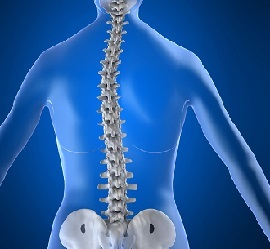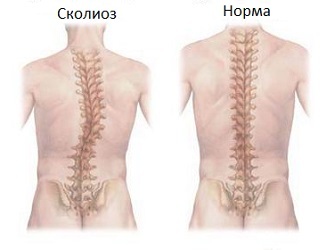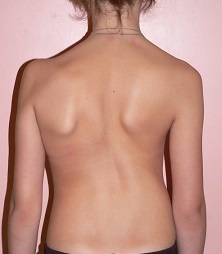 Scoliosis is a stable lateral curvature of the spine in the right or left side relative to its axis in the frontal plane.
Scoliosis is a stable lateral curvature of the spine in the right or left side relative to its axis in the frontal plane.
Its symptoms are easily seen from the side of another person, however it is difficult to diagnose in oneself. As the disease progresses, there is a secondary deformation of the chest and pelvis, accompanied by a violation of the function of the heart, lungs and pelvic organs. The disease was known in ancient times. The term means - a curve, a curved vertebral column, was suggested by Galen back in the II c.n.e.
Scoliosis of the 1 st and 2 nd degree is well camouflaged, so adults do not even suspect about the presence of this disease. The danger of scoliosis is the clamping of nerve fibers, the violation of their communication, the displacement or squeezing of certain internal organs, the deterioration of respiratory functions. Severe forms of the disease can lead to serious disruption of the internal organs and the formation of disabilities.
If you do not care about how to treat scoliosis, then it starts to progress and worsen. So, a scoliosis of 1 degree can smoothly pass to 2nd and even 3-4 degrees, and then to remain for the rest of life. Among children with orthopedic diseases, up to 30% suffer from this disease.
Causes of scoliosis
What is it? Scoliosis of the spine especially rapidly progresses during the development of the child, as it extends in growth, that is, it is the age interval of 6-17 years. Particular attention should be given to proper posture during school lessons, when the child is sitting at a desk for a long time. Very often children lean on one side, so it was more comfortable to sit, thereby provoking lateral curvature of the spine, that is - scoliosis.
Congenital type of disease occurs against a background of various anomalies in the development of the skeleton or spinal cord. However, in most cases this is an acquired disease that can occur due to the following factors:
- inactive lifestyle, sitting job, posture problems;
- leg length difference due to hip joint diseases;
- weakness of cartilaginous tissue, tendons.
In the first place in terms of prevalence with a large margin is idiopathic scoliosis - that is, an ailment with an unknown cause. It is about 80% of the total number of cases. Depressing the situation and the fact that girls are exposed to the problem in 4-7 times more often.

Degrees
The classification of scoliosis was developed by Chaklin, and includes 4 degrees.
- 1 degree of scoliosis - it is characterized by asymmetry of the pelvis, some stoop, which is almost invisible to the patient. The shoulders are located at different levels, a careful examination reveals some asymmetry of the waist. At this stage, the spine is curved no more than 10 degrees.
- 2 degree of scoliosis - asymmetric contours of the neck and waist. This defect becomes noticeable in any position of the body. The angle of curvature is from 10 to 20 degrees.
- 3 degree of scoliosis - angle from 26 to 50 degrees. Disease of the third degree is manifested by persistent pain in the back, pronounced deformation( change in form) of the back, a protrusion appears in the rib area( rib hump).
- 4 degree - the angle of curvature exceeds 50 degrees. The cosmetic defect and all previous signs are expressed. Low tolerance even for small physical exertion.
Examination of a patient suffering from scoliosis, under conditions of honey. The institution includes a detailed examination in the standing, sitting and lying position to identify the above characteristics.
Symptoms of scoliosis
 Scoliosis in the early stages, the symptoms are almost absent - the adult or the child is not bothered by any pain and he can consider himself absolutely healthy. With its progression, the person begins to increase fatigue and the volume of movements in the back area is decreasing.
Scoliosis in the early stages, the symptoms are almost absent - the adult or the child is not bothered by any pain and he can consider himself absolutely healthy. With its progression, the person begins to increase fatigue and the volume of movements in the back area is decreasing.
Depending on the stage of the disease, the symptoms are expressed to a greater or lesser extent. Some parents may notice such abnormal poses of their growing child:
- One shoulder stands above the other.
- When the child is standing with his hands to his sides, the distance between the arm and the waist is different from both sides.
- Blades are located asymmetrically - on the concave side the blade is closer to the spine, its angle is bulging.
- With a tilt, the curvature of the spine becomes noticeable.
Symptoms of scoliosis may also vary depending on the type of disease:
- Chest-chest : curvature at the level of 4-5 vertebrae, accompanied by asymmetry of the shoulders.
- The thoracic manifests itself as a curvature at the level of the seventh to ninth vertebrae. There are violations of respiratory functions, the chest is deformed.
- The lumbar corresponds to the curvature of the first-second lumbar vertebrae. Outwardly deformations are insignificant, however this kind of an ailment differs early development of painful sensations.
- With the lumbosacral , the curvature is at the level of the 10th to 12th vertebrae. There are violations of respiratory and blood supply.
- Combined : curvature at the level of 8-9 thoracic and first-second lumbar vertebrae
Scoliosis, diagnosed in a timely manner, will never cause complications such as metabolic disorders or hard-to-compensate headaches.
Treatment of scoliosis
When scoliosis treatment has its own characteristics, which depend on the patient's age, the degree of curvature of the spine and the type of disease. Includes conservative methods( massage, medical gymnastics, etc.) and surgical treatment( operation).
The general rule for the treatment of scoliosis is condition monitoring if the curve is less than 20 degrees. With curves greater than 25 degrees or those that progress 10 degrees, but under control, treatment may be required. It should be borne in mind that the final formation of the spine is completed by the age of 20, and after this age correction of curvature is almost impossible.
Medications( chondroprotectors, vitamins, restorative drugs) in the treatment of scoliosis play only an auxiliary role. At an angle of curvature of up to 15 degrees, in the absence of rotation, specialized gymnastics is shown. At the same time, it is advisable to conduct the first sessions under the guidance of a specialist. Therapeutic gymnastics is extremely important for the development and strengthening of the muscles of the trunk, as well as the formation of a correct posture.
When performing therapeutic gymnastics complexes, sports equipment can be used: gymnastic benches and walls, inclined planes, dumbbells, rollers, ribbons, cuffs, frames, sticks, weights, etc.
Scoliosis of the second degree is not treated as quickly as the first, sometimes onelimination of this disease takes a year. As a treatment, the doctor appoints besides therapeutic gymnastics and massage, respiratory gymnastics, wearing a corset, manual therapy. In most cases, scoliosis does not require surgery. However, severe pain or progressive deformity is an indication for surgery.
Prevention
Parents are required to control that the child always has a straight back, proper posture, in particular, when the child is doing homework or reading. Do not forget about proper nutrition, active lifestyle, the presence of constant physical activity.
Prophylaxis of scoliosis in adults is not much different from prevention in children.
Do they join the army with scoliosis?
Only those who have the first degree of scoliosis are taken into the army. At the 2nd and 3rd degrees confirmed by the roentgenogram, the draftee is sent to the reserve, assigning him the category B, that is, it is limited to go.

How to choose probiotics for the intestines: a list of drugs.

Effective and inexpensive cough syrups for children and adults.

Modern non-steroidal anti-inflammatory drugs.

Review of tablets from the increased pressure of the new generation.
 Antiviral drugs are inexpensive and effective.
Antiviral drugs are inexpensive and effective.



